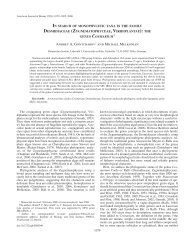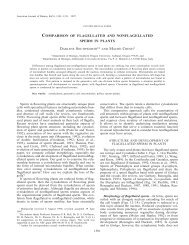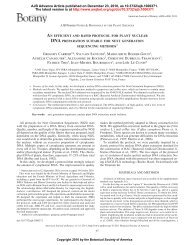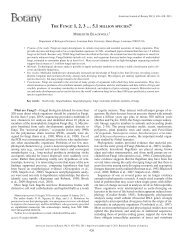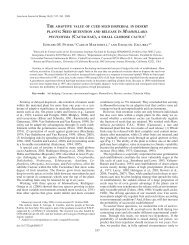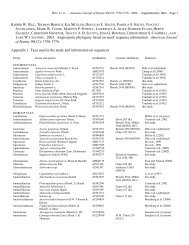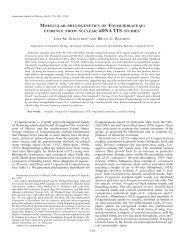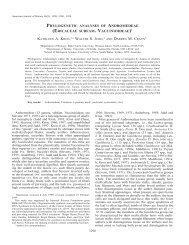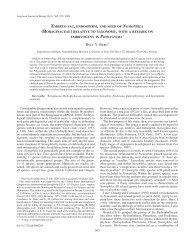genetic variation and structure in the expanding moss pogonatum ...
genetic variation and structure in the expanding moss pogonatum ...
genetic variation and structure in the expanding moss pogonatum ...
You also want an ePaper? Increase the reach of your titles
YUMPU automatically turns print PDFs into web optimized ePapers that Google loves.
October 2005] HASSEL ET AL.—GENETIC DIVERSITY OF AN EXPANDING MOSS<br />
1687<br />
TABLE 3. Genetic variability with<strong>in</strong> populations of Pogonatum dentatum <strong>in</strong> <strong>the</strong> mounta<strong>in</strong>s (M) <strong>and</strong> lowl<strong>and</strong>s (L) of nor<strong>the</strong>rn Sweden, detected by<br />
<strong>in</strong>tersimple sequence repeat (ISSR) analysis.<br />
Population N r /N g S P p A r /A g h s SD H Sr SD/H Sg SD r¯d IER P hap<br />
M1 25/6 8 38.1 1.44/1.66 0.833 0.034 0.151 0.090/0.181 0.122 0.040 ns 0.339 ns 8.2 10 6<br />
M2 25/5 4 19.0 1.24/1.49 0.300 0.118 0.038 0.032/0.095 0.075 0.056 ns ND 0.0176<br />
M3 25/5 9 42.9 1.49/1.79 0.690 0.056 0.158 0.093/0.219 0.151 0.016 ns 0.162 ns 6.2 10 13<br />
M10 25/8 6 28.6 1.34/1.47 0.757 0.060 0.120 0.074/0.153 0.100 0.045 ns 0.050 ns 2.8 10 6<br />
L4 25/12 8 38.1 1.44/1.51 0.910 0.032 0.148 0.089/0.154 0.096 0.023 ns 0.001 ns 1.1 10 9<br />
L5 23/12 10 47.6 1.54/1.61 0.909 0.036 0.186 0.108/0.187 0.113 0.033 ns 0.174 ns 1.5 10 7<br />
L6 25/11 9 42.9 1.49/1.57 0.907 0.032 0.157 0.093/0.168 0.104 0.010 ns 0.034 ns 0.0028<br />
L12 21/11 6 28.6 1.35/1.41 0.891 0.045 0.138 0.084/0.145 0.092 0.042 ns 0.058 ns 0.0001<br />
Note: N r /N g number of sampled ramets <strong>and</strong> genets (haplotypes), respectively; S number of polymorphic sites; P p percentage of polymorphic<br />
loci; A r /A g mean number of alleles per locus (corrected for sample size) at <strong>the</strong> ramet <strong>and</strong> genet level, respectively; h s mean haplotype diversity;<br />
H Sr /H Sg mean gene diversity at <strong>the</strong> ramet <strong>and</strong> genet level, respectively; r¯d multilocus l<strong>in</strong>kage disequilibrium; IER <strong>in</strong>compatibility excess<br />
ratio <strong>and</strong> P hap <strong>the</strong> probability of observ<strong>in</strong>g as many ramets of <strong>the</strong> most common haplotype as actually observed <strong>in</strong> a population <strong>in</strong> a sexually<br />
reproduc<strong>in</strong>g population; L <strong>and</strong> M lowl<strong>and</strong> <strong>and</strong> mounta<strong>in</strong> populations, respectively; ND no data; ns non significant.<br />
The mean allelic richness (A g ) was higher <strong>in</strong> <strong>the</strong> mounta<strong>in</strong><br />
populations (1.53 <strong>in</strong> <strong>the</strong> lowl<strong>and</strong>s vs. 1.60 <strong>in</strong> <strong>the</strong> mounta<strong>in</strong>s).<br />
However, <strong>the</strong>re were no clear differences between <strong>the</strong> mounta<strong>in</strong>s<br />
<strong>and</strong> lowl<strong>and</strong>s <strong>in</strong> gene diversity (H Sg ; Table 3). Multilocus<br />
l<strong>in</strong>kage disequilibrium ( r d ) <strong>and</strong> <strong>the</strong> <strong>in</strong>compatibility excess ratio<br />
(IER) did not reveal significant deviations from <strong>the</strong> assumption<br />
of free recomb<strong>in</strong>ation <strong>in</strong> <strong>the</strong> two study areas. However, <strong>the</strong>re<br />
was a trend toward higher l<strong>in</strong>kage <strong>and</strong> more compatible loci<br />
<strong>in</strong> <strong>the</strong> mounta<strong>in</strong>s relative to <strong>the</strong> lowl<strong>and</strong>s (Table 3).<br />
There were three rare alleles <strong>in</strong> both areas us<strong>in</strong>g <strong>the</strong> 5%<br />
criterion. The mean number of rare alleles <strong>in</strong> <strong>the</strong> populations<br />
was 0.75 <strong>and</strong> 0.50 <strong>in</strong> <strong>the</strong> mounta<strong>in</strong>s <strong>and</strong> lowl<strong>and</strong>s, respectively.<br />
Us<strong>in</strong>g <strong>the</strong> 15% criterion, <strong>the</strong>re were more rare alleles <strong>in</strong> <strong>the</strong><br />
mounta<strong>in</strong>s (9, population mean 2.75) than <strong>in</strong> <strong>the</strong> lowl<strong>and</strong>s (4,<br />
population mean 1.25). Analysis of bottlenecks showed that<br />
three of <strong>the</strong> lowl<strong>and</strong> populations (4, 5 <strong>and</strong> 12) had gone<br />
through a bottleneck, while population 6 was <strong>in</strong> mutation-drift<br />
equilibrium (Table 4). In <strong>the</strong> mounta<strong>in</strong> population 1 had gone<br />
through a bottleneck, while populations 2, 3, <strong>and</strong> 10 were <strong>in</strong><br />
mutation-drift equilibrium (Table 4). These analyses where<br />
done on <strong>the</strong> ramet level; reliable analyses could not be done<br />
at <strong>the</strong> genet level due to low sample size.<br />
Hierarchical analysis of <strong>the</strong> <strong>genetic</strong> <strong>structure</strong> showed that<br />
<strong>the</strong> proportion of total <strong>genetic</strong> <strong>variation</strong> that can be ascribed<br />
to differentiation between <strong>the</strong> mounta<strong>in</strong> <strong>and</strong> lowl<strong>and</strong> areas<br />
(F CT ) is close to zero (Table 5a). Genetic structur<strong>in</strong>g appears<br />
to take place among populations with<strong>in</strong> each area (F SC <br />
0.229) <strong>and</strong> with<strong>in</strong> populations (F ST 0.223). About 80% of<br />
<strong>the</strong> total <strong>genetic</strong> <strong>variation</strong> was due to <strong>variation</strong> with<strong>in</strong> populations<br />
<strong>and</strong> ca. 20% was due to <strong>variation</strong> among populations<br />
with<strong>in</strong> <strong>the</strong> two areas. Separate analyses showed clear differences<br />
between <strong>the</strong> mounta<strong>in</strong>s <strong>and</strong> lowl<strong>and</strong> areas with regard<br />
to <strong>the</strong> partition<strong>in</strong>g of <strong>genetic</strong> <strong>variation</strong> among populations. In<br />
<strong>the</strong> mounta<strong>in</strong>s ca. 30% of <strong>the</strong> <strong>genetic</strong> <strong>variation</strong> was among<br />
populations <strong>in</strong> contrast to ca. 15% <strong>in</strong> <strong>the</strong> lowl<strong>and</strong>s (Table 5b).<br />
Genetic distances were greater among populations <strong>in</strong> <strong>the</strong><br />
mounta<strong>in</strong>s than among <strong>the</strong> lowl<strong>and</strong> populations <strong>and</strong> among <strong>the</strong><br />
mounta<strong>in</strong> vs. lowl<strong>and</strong> populations (F ST , Fig. 3).<br />
Two haplotypes occurred both <strong>in</strong> <strong>the</strong> mounta<strong>in</strong> <strong>and</strong> lowl<strong>and</strong><br />
areas, but no haplotypes were shared among <strong>the</strong> mounta<strong>in</strong> populations.<br />
The lowl<strong>and</strong> population L4 shared three haplotypes<br />
with population L5, <strong>and</strong> population L6 shared one haplotype<br />
with L12. In <strong>the</strong> mounta<strong>in</strong> populations edge patches shared<br />
one or more haplotypes with <strong>the</strong> <strong>in</strong>terior patches. In contrast,<br />
no haplotypes were shared between <strong>the</strong> edge patch <strong>and</strong> <strong>in</strong>terior<br />
patches <strong>in</strong> <strong>the</strong> lowl<strong>and</strong> populations. In fact, <strong>the</strong> same haplotypes<br />
occurred <strong>in</strong> more than one patch only with<strong>in</strong> two of <strong>the</strong><br />
TABLE 4. Results from bottleneck analysis of population of Pogonatum<br />
dentatum <strong>in</strong> <strong>the</strong> mounta<strong>in</strong>s (M) <strong>and</strong> lowl<strong>and</strong>s (L) of nor<strong>the</strong>rn<br />
Sweden.<br />
Fig. 2. Investigation of sampl<strong>in</strong>g scale to see if addition of more loci<br />
would <strong>in</strong>crease haplotypic resolution. Plots of haplotype diversity aga<strong>in</strong>st<br />
number of loci, <strong>in</strong> 100 r<strong>and</strong>om samples of 1–21 loci, were generated to see<br />
if <strong>the</strong> relationship reached a plateau. L <strong>and</strong> M refers to lowl<strong>and</strong>s <strong>and</strong> mounta<strong>in</strong>s,<br />
respectively, numbers (1–6, 10, 12) identify populations.<br />
Sign test<br />
Population N H e /H d SMM<br />
IAM<br />
M1 25 7/1 0.033 0.019<br />
M2 25 1/3 0.075 0.393<br />
M3 25 7/2 0.233 0.055<br />
M10 25 4/2 0.337 0.271<br />
L4 25 7/1 0.031 0.023<br />
L5 23 8/2 0.055 0.023<br />
L6 25 6/3 0.227 0.178<br />
L12 21 6/0 0.023 0.006<br />
Note: P values are shown for a sign test under <strong>the</strong> stepwise mutation<br />
model (SMM) <strong>and</strong> <strong>the</strong> <strong>in</strong>f<strong>in</strong>ite allele model (IAM). N no. of ramets<br />
sampled per polymorphic locus, H e /H d <strong>the</strong> heterozygosity excess/<br />
deficiency ratio.



